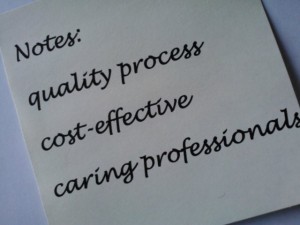 Is Calvin right? How would you describe a good compromise? Does it leave everybody mad? Is a compromise that leaves anybody mad really a good one? I don’t thinks so.
Generally speaking, there are two recognized methods of negotiation:
Is Calvin right? How would you describe a good compromise? Does it leave everybody mad? Is a compromise that leaves anybody mad really a good one? I don’t thinks so.
Generally speaking, there are two recognized methods of negotiation:
- Distributive bargaining, also known as “win-lose,” “zero-sum,” and “divide-the-pie” negotiation, assumes that resources are fixed and that future relationship between the parties is unimportant. Everyday examples include buying a house or car.
- Integrative bargaining, also known as “win-win,” “interest-based,” and “expand-the-pie” negotiation, can lead to better outcomes when issues are complex and the parties value their future relationship.
 There is such a thing as a Do-It-Yourself Divorce. Not that I recommend it, but it’s out there. As an attorney who focuses on Family Law, Mediation and Collaborative Practice, I discourage this route to end a marriage, mainly because of details that can be missed. My definition of a Do-It-Yourself divorce is one in which you and your spouse are handling the entire legal process without any attorney help. This includes gathering information, making decisions, and completing the legal paperwork and processing that paperwork with the court. This is not something you should be doing without help!
Perhaps surprisingly, there are many people who do indeed choose this path: to divorce without the help of an attorney. Especially for those with no children and little to no assets or debts, and likely a shorter marriage, it’s not uncommon. There are free forms available on the Minnesota Supreme Court website that can be printed and used. However, in the following circumstances, clearly an attorney would be helpful: if you have children; significant assets or debts; if you own a house and/or land; if you have been married for many years; if one spouse earns a lot more money than the other.
So, after you determine it is a good idea to procure an attorney to ensure the specifics of your divorce, what next? Are you looking for a courtroom battle? No, of course not. Then why not consider a Collaborative Divorce?
What is a Collaborative Practice divorce, anyway? The most basic definition requires that both spouses have attorneys and everyone signs an agreement not to go to court. The idea is to settle the matter without ever setting foot in a courthouse. Even in a Collaborative Practice divorce the paperwork would be filed at the courthouse, but the attorneys and the clients would never need to have a hearing or even go to the courthouse. The paperwork would just be filed by mail.
Collaborative Practice divorce is an out-of-court settlement process where the attorneys are hired to settle the case and not to go to court and where other neutral professionals often help on the case to provide neutral meeting facilitation, child-focused input or special financial expertise.
Collaborative Practice means more than just the technical completion of the divorce process. It means a commitment to settling the case out of court. It means using neutral experts help educate clients about the unique emotional, child-related and financial circumstances of their particular case and to explore potential settlement options.
For Collaborative Practice professionals, being a member of the Collaborative Law Institute of Minnesota means regularly participating in additional training above and beyond their underlying professional continuing educational requirements. We do this in order to focus specifically on the client experience and out-of-court negotiation and settlement.
As with most things, of course, you get what you pay for. While a do-it-yourself divorce is possible, if instead you are looking for a cost-effective, quality process, take a look at Collaborative Practice divorce. You will be rewarded with a high-quality method that includes professionals that take extra care and training to learn ways to resolve cases outside of court and neutral professionals that will help educate you about your specific circumstances and help you explore your options, all while agreeing not to set foot in a courtroom.
There is such a thing as a Do-It-Yourself Divorce. Not that I recommend it, but it’s out there. As an attorney who focuses on Family Law, Mediation and Collaborative Practice, I discourage this route to end a marriage, mainly because of details that can be missed. My definition of a Do-It-Yourself divorce is one in which you and your spouse are handling the entire legal process without any attorney help. This includes gathering information, making decisions, and completing the legal paperwork and processing that paperwork with the court. This is not something you should be doing without help!
Perhaps surprisingly, there are many people who do indeed choose this path: to divorce without the help of an attorney. Especially for those with no children and little to no assets or debts, and likely a shorter marriage, it’s not uncommon. There are free forms available on the Minnesota Supreme Court website that can be printed and used. However, in the following circumstances, clearly an attorney would be helpful: if you have children; significant assets or debts; if you own a house and/or land; if you have been married for many years; if one spouse earns a lot more money than the other.
So, after you determine it is a good idea to procure an attorney to ensure the specifics of your divorce, what next? Are you looking for a courtroom battle? No, of course not. Then why not consider a Collaborative Divorce?
What is a Collaborative Practice divorce, anyway? The most basic definition requires that both spouses have attorneys and everyone signs an agreement not to go to court. The idea is to settle the matter without ever setting foot in a courthouse. Even in a Collaborative Practice divorce the paperwork would be filed at the courthouse, but the attorneys and the clients would never need to have a hearing or even go to the courthouse. The paperwork would just be filed by mail.
Collaborative Practice divorce is an out-of-court settlement process where the attorneys are hired to settle the case and not to go to court and where other neutral professionals often help on the case to provide neutral meeting facilitation, child-focused input or special financial expertise.
Collaborative Practice means more than just the technical completion of the divorce process. It means a commitment to settling the case out of court. It means using neutral experts help educate clients about the unique emotional, child-related and financial circumstances of their particular case and to explore potential settlement options.
For Collaborative Practice professionals, being a member of the Collaborative Law Institute of Minnesota means regularly participating in additional training above and beyond their underlying professional continuing educational requirements. We do this in order to focus specifically on the client experience and out-of-court negotiation and settlement.
As with most things, of course, you get what you pay for. While a do-it-yourself divorce is possible, if instead you are looking for a cost-effective, quality process, take a look at Collaborative Practice divorce. You will be rewarded with a high-quality method that includes professionals that take extra care and training to learn ways to resolve cases outside of court and neutral professionals that will help educate you about your specific circumstances and help you explore your options, all while agreeing not to set foot in a courtroom.  An attorney representing a client going through collaborative divorce is much more than a legal adviser. The attorney is often a confidant, emotional support system, sounding board, voice of reason, teacher, and financial adviser. Indeed, a collaborative divorce attorney is a “guide.”
The Sherpa people in Nepal inhabit the area surrounding Mount Everest. They have become natural guides up the mountain due to their native knowledge, experience in the region, and superior genetic disposition to function in high altitudes. Like lawyers in divorce – they have gone through this before and they are skilled in the tools necessary for success. Most individuals only experience divorce once. A good collaborative attorney has experienced divorce many times – as a guide. They have honed their skills and can “sherpa” or guide clients through this process in an efficient and successful manner.
I often ask my clients to think back about their wedding. How much of the wedding was legal? It is often a spiritual, emotional, familial, and sometimes a financial endeavor. The legal piece, however, is more minimal. Perhaps you signed some papers a day or two later and mailed them into the state? A divorce is not all that different. Attorneys should advocate and guide their clients to make decisions in their own best interest. However, the attorney role, much like the wedding itself, is multi-faceted and often not solely focused on legal advocacy. A divorce may feel like a long uphill road, like climbing a mountain. A client needs to find an attorney who they trust in all the roles that attorney will play. A good collaborative attorney should be with you on that journey – guiding you up that path to resolution and peace.
An attorney representing a client going through collaborative divorce is much more than a legal adviser. The attorney is often a confidant, emotional support system, sounding board, voice of reason, teacher, and financial adviser. Indeed, a collaborative divorce attorney is a “guide.”
The Sherpa people in Nepal inhabit the area surrounding Mount Everest. They have become natural guides up the mountain due to their native knowledge, experience in the region, and superior genetic disposition to function in high altitudes. Like lawyers in divorce – they have gone through this before and they are skilled in the tools necessary for success. Most individuals only experience divorce once. A good collaborative attorney has experienced divorce many times – as a guide. They have honed their skills and can “sherpa” or guide clients through this process in an efficient and successful manner.
I often ask my clients to think back about their wedding. How much of the wedding was legal? It is often a spiritual, emotional, familial, and sometimes a financial endeavor. The legal piece, however, is more minimal. Perhaps you signed some papers a day or two later and mailed them into the state? A divorce is not all that different. Attorneys should advocate and guide their clients to make decisions in their own best interest. However, the attorney role, much like the wedding itself, is multi-faceted and often not solely focused on legal advocacy. A divorce may feel like a long uphill road, like climbing a mountain. A client needs to find an attorney who they trust in all the roles that attorney will play. A good collaborative attorney should be with you on that journey – guiding you up that path to resolution and peace.  I had a familiar conversation recently, this time on the golf course. As with life, golf is both precise and random: precise because there are exactly 18 holes to play, and random because a golfer never quite knows how the ball will fly from time to time nor with whom the starter will pair you up to play. We were paired with two great golfers who both happened to be named Sean.
I had a familiar conversation recently, this time on the golf course. As with life, golf is both precise and random: precise because there are exactly 18 holes to play, and random because a golfer never quite knows how the ball will fly from time to time nor with whom the starter will pair you up to play. We were paired with two great golfers who both happened to be named Sean.
Sean #1 asked what I did for a living. I gave him my elevator speech about being a Neutral Child Specialist in Collaborative Team Practice and he said, “Wow, that sounds awesome…..it must be really hard work.” My response is always that sometimes it’s hard work, but mostly it’s very rewarding to help families make the difficult transition from married to unmarried with less acrimony and stress for kids. Sean got a faraway look in his eyes and said, “I can sure see that.”
What he was seeing in his mind’s eye, I can only imagine. But often I will hear from young adults with whom I share my work that they wished Collaborative Team Practice had been available to their family when their parents were getting divorced. I have yet to meet anyone who said, “Well, I for one am very grateful that my parents’ divorce was highly acrimonious and adversarial because it was so character-building for me.”
We can’t pretend that ending a marriage will be a pain-free proposition, especially if there are children involved. Divorce is a life crisis for all family members. Collaborative Team Practice is designed to help keep the crisis of divorce from ever becoming a trauma for a child, because there is a profound difference how each impacts the child’s resilience and sense of hope.
If you are a golfer, here’s another way to think about it. Collaborative Team Practice is both precise and random: precise because there is a structured, supportive format for the process and random because of unique family circumstances and unpredictable challenges that arise from time to time. But the pairing of a family with a Collaborative team has great potential value. Collaborative Team Practice helps parents keep their eye on the ball and the ball on the fairway, away from hazards and deep rough where it could easily get lost.
 When someone mentions divorce, where does your mind go? Do the words “fight,” “bitter,” or “vicious” come up? How about terms like, “teamwork,” “goals,” or “considerate?” It’s interesting to an experienced divorce lawyer how often the expectations include the former terms, and how often, in Collaborative Divorce, the reality includes the latter concepts.
When someone mentions divorce, where does your mind go? Do the words “fight,” “bitter,” or “vicious” come up? How about terms like, “teamwork,” “goals,” or “considerate?” It’s interesting to an experienced divorce lawyer how often the expectations include the former terms, and how often, in Collaborative Divorce, the reality includes the latter concepts.
I was reminded of this recently when a client I represented in a Collaborative divorce five years ago sent me a note. I have always remembered him because of the great shift in his attitude toward his wife by the time the case was over. When we began his divorce, he stated in an early meeting that the couple’s property should be divided in his favor, since he had always earned more than his wife (which is NOT the way the law looks at it). The statement was not well-received, either by his wife OR her attorney.
The couple had been married more than 30 years. As the case drew to a close, it became obvious that her job at a prominent Minnesota corporation, her debt-free house, and the even division of their property and substantial retirement assets would provide for her just fine. The only question left was spousal maintenance. We often see a spouse who doesn’t need financial assistance waiving maintenance—in fact, often the couple mutually agree to take jurisdiction over maintenance away from the court altogether, for all time. When I asked whether she had given any thought to waiving maintenance, she glanced at her veteran lawyer, then shyly said she would waive it. In the next instant, we were all stunned to hear my nuts-and-bolts, cut-and-dried, professional engineer client say, in a voice of genuine warmth, “I don’t think you should do that. You never know. You might need it some day.”
Approaching the end of their marriage as a family-centered problem-solving exercise, rather than a combat, allowed this wife to give up a claim I would have assumed she would keep. And it allowed her husband to decline her offer, in the interest of her potential long-term welfare, a gesture no one would have predicted. Their mutual trust of each other, reaffirmed during their weeks of working together, ultimately allowed them both to make decisions that considered each other’s welfare as much as their own.

